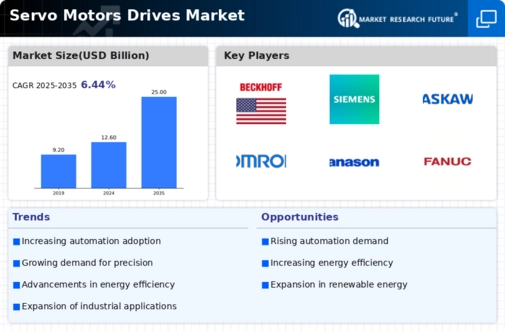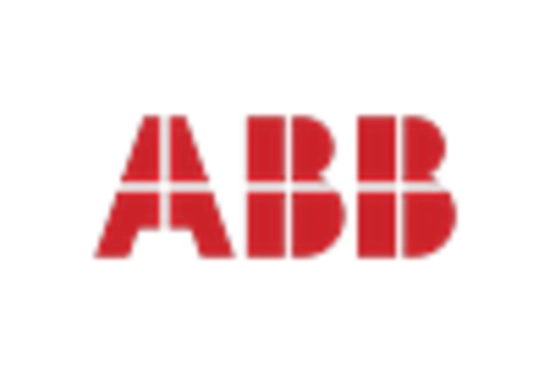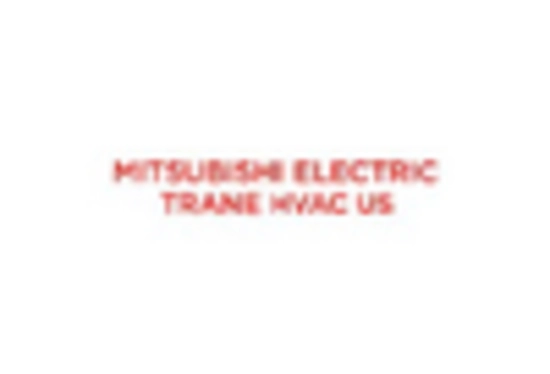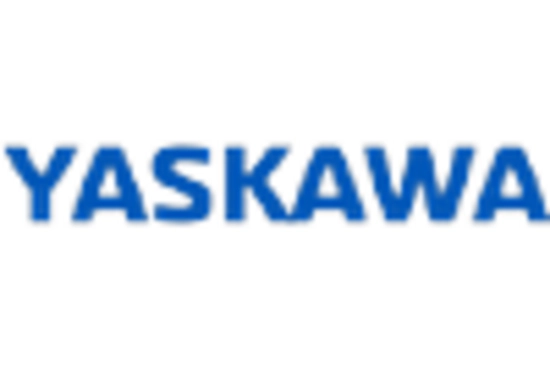-
EXECUTIVE SUMMARY
-
Market Overview
-
Key Findings
-
Market Segmentation
-
Competitive Landscape
-
Challenges and Opportunities
-
Future Outlook
-
\r\n
-
MARKET INTRODUCTION
-
Definition
-
Scope of the study
- Research Objective
- Assumption
- Limitations
-
RESEARCH METHODOLOGY
-
Overview
-
Data Mining
-
Secondary Research
-
Primary Research
- Primary Interviews and Information Gathering Process
- Breakdown of Primary Respondents
-
Forecasting Model
-
Market Size Estimation
- Bottom-Up Approach
- Top-Down Approach
-
Data Triangulation
-
Validation
-
\r\n
-
MARKET DYNAMICS
-
Overview
-
Drivers
-
Restraints
-
Opportunities
-
MARKET FACTOR ANALYSIS
-
Value chain Analysis
-
Porter's Five Forces Analysis
- Bargaining Power of Suppliers
- Bargaining Power of Buyers
- Threat of New Entrants
- Threat of Substitutes
- Intensity of Rivalry
-
COVID-19 Impact Analysis
- Market Impact Analysis
- Regional Impact
- Opportunity and Threat Analysis
-
\r\n
-
SERVO MOTORS DRIVES MARKET, BY TYPE (USD BILLION)
-
AC Servo Motors
-
DC Servo Motors
-
Hybrid Servo Motors
-
SERVO MOTORS DRIVES MARKET, BY APPLICATION (USD BILLION)
-
Robotics
-
CNC Machinery
-
Conveyor Systems
-
Packaging
-
Textile Machinery
-
SERVO MOTORS DRIVES MARKET, BY END USE (USD BILLION)
-
Manufacturing
-
Automotive
-
Aerospace
-
Electronics
-
SERVO MOTORS DRIVES MARKET, BY CONTROL METHOD (USD BILLION)
-
Position Control
-
Velocity Control
-
Torque Control
-
SERVO MOTORS DRIVES MARKET, BY REGIONAL (USD BILLION)
-
North America
- US
- Canada
-
Europe
- Germany
- UK
- France
- Russia
- Italy
- Spain
- Rest of Europe
-
APAC
- China
- India
- Japan
- South Korea
- Malaysia
- Thailand
- Indonesia
- Rest of APAC
-
South America
- Brazil
- Mexico
- Argentina
- Rest of South America
-
MEA
- GCC Countries
- South Africa
- Rest of MEA
-
\r\n
-
COMPETITIVE LANDSCAPE
-
Overview
-
Competitive Analysis
-
Market share Analysis
-
Major Growth Strategy in the Servo Motors Drives Market
-
Competitive Benchmarking
-
Leading Players in Terms of Number of Developments in the Servo Motors Drives Market
-
Key developments and growth strategies
- New Product Launch/Service Deployment
- Merger & Acquisitions
- Joint Ventures
-
Major Players Financial Matrix
- Sales and Operating Income
- Major Players R&D Expenditure. 2023
-
COMPANY PROFILES
-
Beckhoff Automation
- Financial Overview
- Products Offered
- Key Developments
- SWOT Analysis
- Key Strategies
-
Siemens
- Financial Overview
- Products Offered
- Key Developments
- SWOT Analysis
- Key Strategies
-
Yaskawa Electric
- Financial Overview
- Products Offered
- Key Developments
- SWOT Analysis
- Key Strategies
-
Omron
- Financial Overview
- Products Offered
- Key Developments
- SWOT Analysis
- Key Strategies
-
Emerson Electric
- Financial Overview
- Products Offered
- Key Developments
- SWOT Analysis
- Key Strategies
-
Baldor Electric
- Financial Overview
- Products Offered
- Key Developments
- SWOT Analysis
- Key Strategies
-
ABB
- Financial Overview
- Products Offered
- Key Developments
- SWOT Analysis
- Key Strategies
-
Panasonic
- Financial Overview
- Products Offered
- Key Developments
- SWOT Analysis
- Key Strategies
-
Fanuc
- Financial Overview
- Products Offered
- Key Developments
- SWOT Analysis
- Key Strategies
-
SANYO DENKI
- Financial Overview
- Products Offered
- Key Developments
- SWOT Analysis
- Key Strategies
-
Mitsubishi Electric
- Financial Overview
- Products Offered
- Key Developments
- SWOT Analysis
- Key Strategies
-
Rockwell Automation
- Financial Overview
- Products Offered
- Key Developments
- SWOT Analysis
- Key Strategies
-
Kollmorgen
- Financial Overview
- Products Offered
- Key Developments
- SWOT Analysis
- Key Strategies
-
Schneider Electric
- Financial Overview
- Products Offered
- Key Developments
- SWOT Analysis
- Key Strategies
-
Delta Electronics
- Financial Overview
- Products Offered
- Key Developments
- SWOT Analysis
- Key Strategies
-
APPENDIX
-
References
-
Related Reports
-
LIST OF TABLES
-
\r\n
-
LIST OF ASSUMPTIONS
-
NORTH AMERICA SERVO MOTORS DRIVES MARKET SIZE ESTIMATES & FORECAST, BY TYPE, 2019-2035 (USD BILLIONS)
-
NORTH AMERICA SERVO MOTORS DRIVES MARKET SIZE ESTIMATES & FORECAST, BY APPLICATION, 2019-2035 (USD BILLIONS)
-
NORTH AMERICA SERVO MOTORS DRIVES MARKET SIZE ESTIMATES & FORECAST, BY END USE, 2019-2035 (USD BILLIONS)
-
NORTH AMERICA SERVO MOTORS DRIVES MARKET SIZE ESTIMATES & FORECAST, BY CONTROL METHOD, 2019-2035 (USD BILLIONS)
-
NORTH AMERICA SERVO MOTORS DRIVES MARKET SIZE ESTIMATES & FORECAST, BY REGIONAL, 2019-2035 (USD BILLIONS)
-
US SERVO MOTORS DRIVES MARKET SIZE ESTIMATES & FORECAST, BY TYPE, 2019-2035 (USD BILLIONS)
-
US SERVO MOTORS DRIVES MARKET SIZE ESTIMATES & FORECAST, BY APPLICATION, 2019-2035 (USD BILLIONS)
-
US SERVO MOTORS DRIVES MARKET SIZE ESTIMATES & FORECAST, BY END USE, 2019-2035 (USD BILLIONS)
-
US SERVO MOTORS DRIVES MARKET SIZE ESTIMATES & FORECAST, BY CONTROL METHOD, 2019-2035 (USD BILLIONS)
-
US SERVO MOTORS DRIVES MARKET SIZE ESTIMATES & FORECAST, BY REGIONAL, 2019-2035 (USD BILLIONS)
-
CANADA SERVO MOTORS DRIVES MARKET SIZE ESTIMATES & FORECAST, BY TYPE, 2019-2035 (USD BILLIONS)
-
CANADA SERVO MOTORS DRIVES MARKET SIZE ESTIMATES & FORECAST, BY APPLICATION, 2019-2035 (USD BILLIONS)
-
CANADA SERVO MOTORS DRIVES MARKET SIZE ESTIMATES & FORECAST, BY END USE, 2019-2035 (USD BILLIONS)
-
CANADA SERVO MOTORS DRIVES MARKET SIZE ESTIMATES & FORECAST, BY CONTROL METHOD, 2019-2035 (USD BILLIONS)
-
CANADA SERVO MOTORS DRIVES MARKET SIZE ESTIMATES & FORECAST, BY REGIONAL, 2019-2035 (USD BILLIONS)
-
EUROPE SERVO MOTORS DRIVES MARKET SIZE ESTIMATES & FORECAST, BY TYPE, 2019-2035 (USD BILLIONS)
-
EUROPE SERVO MOTORS DRIVES MARKET SIZE ESTIMATES & FORECAST, BY APPLICATION, 2019-2035 (USD BILLIONS)
-
EUROPE SERVO MOTORS DRIVES MARKET SIZE ESTIMATES & FORECAST, BY END USE, 2019-2035 (USD BILLIONS)
-
EUROPE SERVO MOTORS DRIVES MARKET SIZE ESTIMATES & FORECAST, BY CONTROL METHOD, 2019-2035 (USD BILLIONS)
-
EUROPE SERVO MOTORS DRIVES MARKET SIZE ESTIMATES & FORECAST, BY REGIONAL, 2019-2035 (USD BILLIONS)
-
GERMANY SERVO MOTORS DRIVES MARKET SIZE ESTIMATES & FORECAST, BY TYPE, 2019-2035 (USD BILLIONS)
-
GERMANY SERVO MOTORS DRIVES MARKET SIZE ESTIMATES & FORECAST, BY APPLICATION, 2019-2035 (USD BILLIONS)
-
GERMANY SERVO MOTORS DRIVES MARKET SIZE ESTIMATES & FORECAST, BY END USE, 2019-2035 (USD BILLIONS)
-
GERMANY SERVO MOTORS DRIVES MARKET SIZE ESTIMATES & FORECAST, BY CONTROL METHOD, 2019-2035 (USD BILLIONS)
-
GERMANY SERVO MOTORS DRIVES MARKET SIZE ESTIMATES & FORECAST, BY REGIONAL, 2019-2035 (USD BILLIONS)
-
UK SERVO MOTORS DRIVES MARKET SIZE ESTIMATES & FORECAST, BY TYPE, 2019-2035 (USD BILLIONS)
-
UK SERVO MOTORS DRIVES MARKET SIZE ESTIMATES & FORECAST, BY APPLICATION, 2019-2035 (USD BILLIONS)
-
UK SERVO MOTORS DRIVES MARKET SIZE ESTIMATES & FORECAST, BY END USE, 2019-2035 (USD BILLIONS)
-
UK SERVO MOTORS DRIVES MARKET SIZE ESTIMATES & FORECAST, BY CONTROL METHOD, 2019-2035 (USD BILLIONS)
-
UK SERVO MOTORS DRIVES MARKET SIZE ESTIMATES & FORECAST, BY REGIONAL, 2019-2035 (USD BILLIONS)
-
FRANCE SERVO MOTORS DRIVES MARKET SIZE ESTIMATES & FORECAST, BY TYPE, 2019-2035 (USD BILLIONS)
-
FRANCE SERVO MOTORS DRIVES MARKET SIZE ESTIMATES & FORECAST, BY APPLICATION, 2019-2035 (USD BILLIONS)
-
FRANCE SERVO MOTORS DRIVES MARKET SIZE ESTIMATES & FORECAST, BY END USE, 2019-2035 (USD BILLIONS)
-
FRANCE SERVO MOTORS DRIVES MARKET SIZE ESTIMATES & FORECAST, BY CONTROL METHOD, 2019-2035 (USD BILLIONS)
-
FRANCE SERVO MOTORS DRIVES MARKET SIZE ESTIMATES & FORECAST, BY REGIONAL, 2019-2035 (USD BILLIONS)
-
RUSSIA SERVO MOTORS DRIVES MARKET SIZE ESTIMATES & FORECAST, BY TYPE, 2019-2035 (USD BILLIONS)
-
RUSSIA SERVO MOTORS DRIVES MARKET SIZE ESTIMATES & FORECAST, BY APPLICATION, 2019-2035 (USD BILLIONS)
-
RUSSIA SERVO MOTORS DRIVES MARKET SIZE ESTIMATES & FORECAST, BY END USE, 2019-2035 (USD BILLIONS)
-
RUSSIA SERVO MOTORS DRIVES MARKET SIZE ESTIMATES & FORECAST, BY CONTROL METHOD, 2019-2035 (USD BILLIONS)
-
RUSSIA SERVO MOTORS DRIVES MARKET SIZE ESTIMATES & FORECAST, BY REGIONAL, 2019-2035 (USD BILLIONS)
-
ITALY SERVO MOTORS DRIVES MARKET SIZE ESTIMATES & FORECAST, BY TYPE, 2019-2035 (USD BILLIONS)
-
ITALY SERVO MOTORS DRIVES MARKET SIZE ESTIMATES & FORECAST, BY APPLICATION, 2019-2035 (USD BILLIONS)
-
ITALY SERVO MOTORS DRIVES MARKET SIZE ESTIMATES & FORECAST, BY END USE, 2019-2035 (USD BILLIONS)
-
ITALY SERVO MOTORS DRIVES MARKET SIZE ESTIMATES & FORECAST, BY CONTROL METHOD, 2019-2035 (USD BILLIONS)
-
ITALY SERVO MOTORS DRIVES MARKET SIZE ESTIMATES & FORECAST, BY REGIONAL, 2019-2035 (USD BILLIONS)
-
SPAIN SERVO MOTORS DRIVES MARKET SIZE ESTIMATES & FORECAST, BY TYPE, 2019-2035 (USD BILLIONS)
-
SPAIN SERVO MOTORS DRIVES MARKET SIZE ESTIMATES & FORECAST, BY APPLICATION, 2019-2035 (USD BILLIONS)
-
SPAIN SERVO MOTORS DRIVES MARKET SIZE ESTIMATES & FORECAST, BY END USE, 2019-2035 (USD BILLIONS)
-
SPAIN SERVO MOTORS DRIVES MARKET SIZE ESTIMATES & FORECAST, BY CONTROL METHOD, 2019-2035 (USD BILLIONS)
-
SPAIN SERVO MOTORS DRIVES MARKET SIZE ESTIMATES & FORECAST, BY REGIONAL, 2019-2035 (USD BILLIONS)
-
REST OF EUROPE SERVO MOTORS DRIVES MARKET SIZE ESTIMATES & FORECAST, BY TYPE, 2019-2035 (USD BILLIONS)
-
REST OF EUROPE SERVO MOTORS DRIVES MARKET SIZE ESTIMATES & FORECAST, BY APPLICATION, 2019-2035 (USD BILLIONS)
-
REST OF EUROPE SERVO MOTORS DRIVES MARKET SIZE ESTIMATES & FORECAST, BY END USE, 2019-2035 (USD BILLIONS)
-
REST OF EUROPE SERVO MOTORS DRIVES MARKET SIZE ESTIMATES & FORECAST, BY CONTROL METHOD, 2019-2035 (USD BILLIONS)
-
REST OF EUROPE SERVO MOTORS DRIVES MARKET SIZE ESTIMATES & FORECAST, BY REGIONAL, 2019-2035 (USD BILLIONS)
-
APAC SERVO MOTORS DRIVES MARKET SIZE ESTIMATES & FORECAST, BY TYPE, 2019-2035 (USD BILLIONS)
-
APAC SERVO MOTORS DRIVES MARKET SIZE ESTIMATES & FORECAST, BY APPLICATION, 2019-2035 (USD BILLIONS)
-
APAC SERVO MOTORS DRIVES MARKET SIZE ESTIMATES & FORECAST, BY END USE, 2019-2035 (USD BILLIONS)
-
APAC SERVO MOTORS DRIVES MARKET SIZE ESTIMATES & FORECAST, BY CONTROL METHOD, 2019-2035 (USD BILLIONS)
-
APAC SERVO MOTORS DRIVES MARKET SIZE ESTIMATES & FORECAST, BY REGIONAL, 2019-2035 (USD BILLIONS)
-
CHINA SERVO MOTORS DRIVES MARKET SIZE ESTIMATES & FORECAST, BY TYPE, 2019-2035 (USD BILLIONS)
-
CHINA SERVO MOTORS DRIVES MARKET SIZE ESTIMATES & FORECAST, BY APPLICATION, 2019-2035 (USD BILLIONS)
-
CHINA SERVO MOTORS DRIVES MARKET SIZE ESTIMATES & FORECAST, BY END USE, 2019-2035 (USD BILLIONS)
-
CHINA SERVO MOTORS DRIVES MARKET SIZE ESTIMATES & FORECAST, BY CONTROL METHOD, 2019-2035 (USD BILLIONS)
-
CHINA SERVO MOTORS DRIVES MARKET SIZE ESTIMATES & FORECAST, BY REGIONAL, 2019-2035 (USD BILLIONS)
-
INDIA SERVO MOTORS DRIVES MARKET SIZE ESTIMATES & FORECAST, BY TYPE, 2019-2035 (USD BILLIONS)
-
INDIA SERVO MOTORS DRIVES MARKET SIZE ESTIMATES & FORECAST, BY APPLICATION, 2019-2035 (USD BILLIONS)
-
INDIA SERVO MOTORS DRIVES MARKET SIZE ESTIMATES & FORECAST, BY END USE, 2019-2035 (USD BILLIONS)
-
INDIA SERVO MOTORS DRIVES MARKET SIZE ESTIMATES & FORECAST, BY CONTROL METHOD, 2019-2035 (USD BILLIONS)
-
INDIA SERVO MOTORS DRIVES MARKET SIZE ESTIMATES & FORECAST, BY REGIONAL, 2019-2035 (USD BILLIONS)
-
JAPAN SERVO MOTORS DRIVES MARKET SIZE ESTIMATES & FORECAST, BY TYPE, 2019-2035 (USD BILLIONS)
-
JAPAN SERVO MOTORS DRIVES MARKET SIZE ESTIMATES & FORECAST, BY APPLICATION, 2019-2035 (USD BILLIONS)
-
JAPAN SERVO MOTORS DRIVES MARKET SIZE ESTIMATES & FORECAST, BY END USE, 2019-2035 (USD BILLIONS)
-
JAPAN SERVO MOTORS DRIVES MARKET SIZE ESTIMATES & FORECAST, BY CONTROL METHOD, 2019-2035 (USD BILLIONS)
-
JAPAN SERVO MOTORS DRIVES MARKET SIZE ESTIMATES & FORECAST, BY REGIONAL, 2019-2035 (USD BILLIONS)
-
SOUTH KOREA SERVO MOTORS DRIVES MARKET SIZE ESTIMATES & FORECAST, BY TYPE, 2019-2035 (USD BILLIONS)
-
SOUTH KOREA SERVO MOTORS DRIVES MARKET SIZE ESTIMATES & FORECAST, BY APPLICATION, 2019-2035 (USD BILLIONS)
-
SOUTH KOREA SERVO MOTORS DRIVES MARKET SIZE ESTIMATES & FORECAST, BY END USE, 2019-2035 (USD BILLIONS)
-
SOUTH KOREA SERVO MOTORS DRIVES MARKET SIZE ESTIMATES & FORECAST, BY CONTROL METHOD, 2019-2035 (USD BILLIONS)
-
SOUTH KOREA SERVO MOTORS DRIVES MARKET SIZE ESTIMATES & FORECAST, BY REGIONAL, 2019-2035 (USD BILLIONS)
-
MALAYSIA SERVO MOTORS DRIVES MARKET SIZE ESTIMATES & FORECAST, BY TYPE, 2019-2035 (USD BILLIONS)
-
MALAYSIA SERVO MOTORS DRIVES MARKET SIZE ESTIMATES & FORECAST, BY APPLICATION, 2019-2035 (USD BILLIONS)
-
MALAYSIA SERVO MOTORS DRIVES MARKET SIZE ESTIMATES & FORECAST, BY END USE, 2019-2035 (USD BILLIONS)
-
MALAYSIA SERVO MOTORS DRIVES MARKET SIZE ESTIMATES & FORECAST, BY CONTROL METHOD, 2019-2035 (USD BILLIONS)
-
MALAYSIA SERVO MOTORS DRIVES MARKET SIZE ESTIMATES & FORECAST, BY REGIONAL, 2019-2035 (USD BILLIONS)
-
THAILAND SERVO MOTORS DRIVES MARKET SIZE ESTIMATES & FORECAST, BY TYPE, 2019-2035 (USD BILLIONS)
-
THAILAND SERVO MOTORS DRIVES MARKET SIZE ESTIMATES & FORECAST, BY APPLICATION, 2019-2035 (USD BILLIONS)
-
THAILAND SERVO MOTORS DRIVES MARKET SIZE ESTIMATES & FORECAST, BY END USE, 2019-2035 (USD BILLIONS)
-
THAILAND SERVO MOTORS DRIVES MARKET SIZE ESTIMATES & FORECAST, BY CONTROL METHOD, 2019-2035 (USD BILLIONS)
-
THAILAND SERVO MOTORS DRIVES MARKET SIZE ESTIMATES & FORECAST, BY REGIONAL, 2019-2035 (USD BILLIONS)
-
INDONESIA SERVO MOTORS DRIVES MARKET SIZE ESTIMATES & FORECAST, BY TYPE, 2019-2035 (USD BILLIONS)
-
INDONESIA SERVO MOTORS DRIVES MARKET SIZE ESTIMATES & FORECAST, BY APPLICATION, 2019-2035 (USD BILLIONS)
-
INDONESIA SERVO MOTORS DRIVES MARKET SIZE ESTIMATES & FORECAST, BY END USE, 2019-2035 (USD BILLIONS)
-
INDONESIA SERVO MOTORS DRIVES MARKET SIZE ESTIMATES & FORECAST, BY CONTROL METHOD, 2019-2035 (USD BILLIONS)
-
INDONESIA SERVO MOTORS DRIVES MARKET SIZE ESTIMATES & FORECAST, BY REGIONAL, 2019-2035 (USD BILLIONS)
-
REST OF APAC SERVO MOTORS DRIVES MARKET SIZE ESTIMATES & FORECAST, BY TYPE, 2019-2035 (USD BILLIONS)
-
REST OF APAC SERVO MOTORS DRIVES MARKET SIZE ESTIMATES & FORECAST, BY APPLICATION, 2019-2035 (USD BILLIONS)
-
REST OF APAC SERVO MOTORS DRIVES MARKET SIZE ESTIMATES & FORECAST, BY END USE, 2019-2035 (USD BILLIONS)
-
REST OF APAC SERVO MOTORS DRIVES MARKET SIZE ESTIMATES & FORECAST, BY CONTROL METHOD, 2019-2035 (USD BILLIONS)
-
REST OF APAC SERVO MOTORS DRIVES MARKET SIZE ESTIMATES & FORECAST, BY REGIONAL, 2019-2035 (USD BILLIONS)
-
SOUTH AMERICA SERVO MOTORS DRIVES MARKET SIZE ESTIMATES & FORECAST, BY TYPE, 2019-2035 (USD BILLIONS)
-
SOUTH AMERICA SERVO MOTORS DRIVES MARKET SIZE ESTIMATES & FORECAST, BY APPLICATION, 2019-2035 (USD BILLIONS)
-
SOUTH AMERICA SERVO MOTORS DRIVES MARKET SIZE ESTIMATES & FORECAST, BY END USE, 2019-2035 (USD BILLIONS)
-
SOUTH AMERICA SERVO MOTORS DRIVES MARKET SIZE ESTIMATES & FORECAST, BY CONTROL METHOD, 2019-2035 (USD BILLIONS)
-
SOUTH AMERICA SERVO MOTORS DRIVES MARKET SIZE ESTIMATES & FORECAST, BY REGIONAL, 2019-2035 (USD BILLIONS)
-
BRAZIL SERVO MOTORS DRIVES MARKET SIZE ESTIMATES & FORECAST, BY TYPE, 2019-2035 (USD BILLIONS)
-
BRAZIL SERVO MOTORS DRIVES MARKET SIZE ESTIMATES & FORECAST, BY APPLICATION, 2019-2035 (USD BILLIONS)
-
BRAZIL SERVO MOTORS DRIVES MARKET SIZE ESTIMATES & FORECAST, BY END USE, 2019-2035 (USD BILLIONS)
-
BRAZIL SERVO MOTORS DRIVES MARKET SIZE ESTIMATES & FORECAST, BY CONTROL METHOD, 2019-2035 (USD BILLIONS)
-
BRAZIL SERVO MOTORS DRIVES MARKET SIZE ESTIMATES & FORECAST, BY REGIONAL, 2019-2035 (USD BILLIONS)
-
MEXICO SERVO MOTORS DRIVES MARKET SIZE ESTIMATES & FORECAST, BY TYPE, 2019-2035 (USD BILLIONS)
-
MEXICO SERVO MOTORS DRIVES MARKET SIZE ESTIMATES & FORECAST, BY APPLICATION, 2019-2035 (USD BILLIONS)
-
MEXICO SERVO MOTORS DRIVES MARKET SIZE ESTIMATES & FORECAST, BY END USE, 2019-2035 (USD BILLIONS)
-
MEXICO SERVO MOTORS DRIVES MARKET SIZE ESTIMATES & FORECAST, BY CONTROL METHOD, 2019-2035 (USD BILLIONS)
-
MEXICO SERVO MOTORS DRIVES MARKET SIZE ESTIMATES & FORECAST, BY REGIONAL, 2019-2035 (USD BILLIONS)
-
ARGENTINA SERVO MOTORS DRIVES MARKET SIZE ESTIMATES & FORECAST, BY TYPE, 2019-2035 (USD BILLIONS)
-
ARGENTINA SERVO MOTORS DRIVES MARKET SIZE ESTIMATES & FORECAST, BY APPLICATION, 2019-2035 (USD BILLIONS)
-
ARGENTINA SERVO MOTORS DRIVES MARKET SIZE ESTIMATES & FORECAST, BY END USE, 2019-2035 (USD BILLIONS)
-
ARGENTINA SERVO MOTORS DRIVES MARKET SIZE ESTIMATES & FORECAST, BY CONTROL METHOD, 2019-2035 (USD BILLIONS)
-
ARGENTINA SERVO MOTORS DRIVES MARKET SIZE ESTIMATES & FORECAST, BY REGIONAL, 2019-2035 (USD BILLIONS)
-
REST OF SOUTH AMERICA SERVO MOTORS DRIVES MARKET SIZE ESTIMATES & FORECAST, BY TYPE, 2019-2035 (USD BILLIONS)
-
REST OF SOUTH AMERICA SERVO MOTORS DRIVES MARKET SIZE ESTIMATES & FORECAST, BY APPLICATION, 2019-2035 (USD BILLIONS)
-
REST OF SOUTH AMERICA SERVO MOTORS DRIVES MARKET SIZE ESTIMATES & FORECAST, BY END USE, 2019-2035 (USD BILLIONS)
-
REST OF SOUTH AMERICA SERVO MOTORS DRIVES MARKET SIZE ESTIMATES & FORECAST, BY CONTROL METHOD, 2019-2035 (USD BILLIONS)
-
REST OF SOUTH AMERICA SERVO MOTORS DRIVES MARKET SIZE ESTIMATES & FORECAST, BY REGIONAL, 2019-2035 (USD BILLIONS)
-
MEA SERVO MOTORS DRIVES MARKET SIZE ESTIMATES & FORECAST, BY TYPE, 2019-2035 (USD BILLIONS)
-
MEA SERVO MOTORS DRIVES MARKET SIZE ESTIMATES & FORECAST, BY APPLICATION, 2019-2035 (USD BILLIONS)
-
MEA SERVO MOTORS DRIVES MARKET SIZE ESTIMATES & FORECAST, BY END USE, 2019-2035 (USD BILLIONS)
-
MEA SERVO MOTORS DRIVES MARKET SIZE ESTIMATES & FORECAST, BY CONTROL METHOD, 2019-2035 (USD BILLIONS)
-
MEA SERVO MOTORS DRIVES MARKET SIZE ESTIMATES & FORECAST, BY REGIONAL, 2019-2035 (USD BILLIONS)
-
GCC COUNTRIES SERVO MOTORS DRIVES MARKET SIZE ESTIMATES & FORECAST, BY TYPE, 2019-2035 (USD BILLIONS)
-
GCC COUNTRIES SERVO MOTORS DRIVES MARKET SIZE ESTIMATES & FORECAST, BY APPLICATION, 2019-2035 (USD BILLIONS)
-
GCC COUNTRIES SERVO MOTORS DRIVES MARKET SIZE ESTIMATES & FORECAST, BY END USE, 2019-2035 (USD BILLIONS)
-
GCC COUNTRIES SERVO MOTORS DRIVES MARKET SIZE ESTIMATES & FORECAST, BY CONTROL METHOD, 2019-2035 (USD BILLIONS)
-
GCC COUNTRIES SERVO MOTORS DRIVES MARKET SIZE ESTIMATES & FORECAST, BY REGIONAL, 2019-2035 (USD BILLIONS)
-
SOUTH AFRICA SERVO MOTORS DRIVES MARKET SIZE ESTIMATES & FORECAST, BY TYPE, 2019-2035 (USD BILLIONS)
-
SOUTH AFRICA SERVO MOTORS DRIVES MARKET SIZE ESTIMATES & FORECAST, BY APPLICATION, 2019-2035 (USD BILLIONS)
-
SOUTH AFRICA SERVO MOTORS DRIVES MARKET SIZE ESTIMATES & FORECAST, BY END USE, 2019-2035 (USD BILLIONS)
-
SOUTH AFRICA SERVO MOTORS DRIVES MARKET SIZE ESTIMATES & FORECAST, BY CONTROL METHOD, 2019-2035 (USD BILLIONS)
-
SOUTH AFRICA SERVO MOTORS DRIVES MARKET SIZE ESTIMATES & FORECAST, BY REGIONAL, 2019-2035 (USD BILLIONS)
-
REST OF MEA SERVO MOTORS DRIVES MARKET SIZE ESTIMATES & FORECAST, BY TYPE, 2019-2035 (USD BILLIONS)
-
REST OF MEA SERVO MOTORS DRIVES MARKET SIZE ESTIMATES & FORECAST, BY APPLICATION, 2019-2035 (USD BILLIONS)
-
REST OF MEA SERVO MOTORS DRIVES MARKET SIZE ESTIMATES & FORECAST, BY END USE, 2019-2035 (USD BILLIONS)
-
REST OF MEA SERVO MOTORS DRIVES MARKET SIZE ESTIMATES & FORECAST, BY CONTROL METHOD, 2019-2035 (USD BILLIONS)
-
REST OF MEA SERVO MOTORS DRIVES MARKET SIZE ESTIMATES & FORECAST, BY REGIONAL, 2019-2035 (USD BILLIONS)
-
PRODUCT LAUNCH/PRODUCT DEVELOPMENT/APPROVAL
-
ACQUISITION/PARTNERSHIP
-
\r\n
-
\r\n
-
\r\n
-
\r\n
-
\r\n
-
\r\n
-
\r\n
-
\r\n
-
\r\n
-
\r\n
-
\r\n
-
\r\n
-
\r\n
-
\r\n
-
\r\n
-
LIST OF FIGURES
-
\r\n
-
MARKET SYNOPSIS
-
NORTH AMERICA SERVO MOTORS DRIVES MARKET ANALYSIS
-
US SERVO MOTORS DRIVES MARKET ANALYSIS BY TYPE
-
US SERVO MOTORS DRIVES MARKET ANALYSIS BY APPLICATION
-
US SERVO MOTORS DRIVES MARKET ANALYSIS BY END USE
-
US SERVO MOTORS DRIVES MARKET ANALYSIS BY CONTROL METHOD
-
US SERVO MOTORS DRIVES MARKET ANALYSIS BY REGIONAL
-
CANADA SERVO MOTORS DRIVES MARKET ANALYSIS BY TYPE
-
CANADA SERVO MOTORS DRIVES MARKET ANALYSIS BY APPLICATION
-
CANADA SERVO MOTORS DRIVES MARKET ANALYSIS BY END USE
-
CANADA SERVO MOTORS DRIVES MARKET ANALYSIS BY CONTROL METHOD
-
CANADA SERVO MOTORS DRIVES MARKET ANALYSIS BY REGIONAL
-
EUROPE SERVO MOTORS DRIVES MARKET ANALYSIS
-
GERMANY SERVO MOTORS DRIVES MARKET ANALYSIS BY TYPE
-
GERMANY SERVO MOTORS DRIVES MARKET ANALYSIS BY APPLICATION
-
GERMANY SERVO MOTORS DRIVES MARKET ANALYSIS BY END USE
-
GERMANY SERVO MOTORS DRIVES MARKET ANALYSIS BY CONTROL METHOD
-
GERMANY SERVO MOTORS DRIVES MARKET ANALYSIS BY REGIONAL
-
UK SERVO MOTORS DRIVES MARKET ANALYSIS BY TYPE
-
UK SERVO MOTORS DRIVES MARKET ANALYSIS BY APPLICATION
-
UK SERVO MOTORS DRIVES MARKET ANALYSIS BY END USE
-
UK SERVO MOTORS DRIVES MARKET ANALYSIS BY CONTROL METHOD
-
UK SERVO MOTORS DRIVES MARKET ANALYSIS BY REGIONAL
-
FRANCE SERVO MOTORS DRIVES MARKET ANALYSIS BY TYPE
-
FRANCE SERVO MOTORS DRIVES MARKET ANALYSIS BY APPLICATION
-
FRANCE SERVO MOTORS DRIVES MARKET ANALYSIS BY END USE
-
FRANCE SERVO MOTORS DRIVES MARKET ANALYSIS BY CONTROL METHOD
-
FRANCE SERVO MOTORS DRIVES MARKET ANALYSIS BY REGIONAL
-
RUSSIA SERVO MOTORS DRIVES MARKET ANALYSIS BY TYPE
-
RUSSIA SERVO MOTORS DRIVES MARKET ANALYSIS BY APPLICATION
-
RUSSIA SERVO MOTORS DRIVES MARKET ANALYSIS BY END USE
-
RUSSIA SERVO MOTORS DRIVES MARKET ANALYSIS BY CONTROL METHOD
-
RUSSIA SERVO MOTORS DRIVES MARKET ANALYSIS BY REGIONAL
-
ITALY SERVO MOTORS DRIVES MARKET ANALYSIS BY TYPE
-
ITALY SERVO MOTORS DRIVES MARKET ANALYSIS BY APPLICATION
-
ITALY SERVO MOTORS DRIVES MARKET ANALYSIS BY END USE
-
ITALY SERVO MOTORS DRIVES MARKET ANALYSIS BY CONTROL METHOD
-
ITALY SERVO MOTORS DRIVES MARKET ANALYSIS BY REGIONAL
-
SPAIN SERVO MOTORS DRIVES MARKET ANALYSIS BY TYPE
-
SPAIN SERVO MOTORS DRIVES MARKET ANALYSIS BY APPLICATION
-
SPAIN SERVO MOTORS DRIVES MARKET ANALYSIS BY END USE
-
SPAIN SERVO MOTORS DRIVES MARKET ANALYSIS BY CONTROL METHOD
-
SPAIN SERVO MOTORS DRIVES MARKET ANALYSIS BY REGIONAL
-
REST OF EUROPE SERVO MOTORS DRIVES MARKET ANALYSIS BY TYPE
-
REST OF EUROPE SERVO MOTORS DRIVES MARKET ANALYSIS BY APPLICATION
-
REST OF EUROPE SERVO MOTORS DRIVES MARKET ANALYSIS BY END USE
-
REST OF EUROPE SERVO MOTORS DRIVES MARKET ANALYSIS BY CONTROL METHOD
-
REST OF EUROPE SERVO MOTORS DRIVES MARKET ANALYSIS BY REGIONAL
-
APAC SERVO MOTORS DRIVES MARKET ANALYSIS
-
CHINA SERVO MOTORS DRIVES MARKET ANALYSIS BY TYPE
-
CHINA SERVO MOTORS DRIVES MARKET ANALYSIS BY APPLICATION
-
CHINA SERVO MOTORS DRIVES MARKET ANALYSIS BY END USE
-
CHINA SERVO MOTORS DRIVES MARKET ANALYSIS BY CONTROL METHOD
-
CHINA SERVO MOTORS DRIVES MARKET ANALYSIS BY REGIONAL
-
INDIA SERVO MOTORS DRIVES MARKET ANALYSIS BY TYPE
-
INDIA SERVO MOTORS DRIVES MARKET ANALYSIS BY APPLICATION
-
INDIA SERVO MOTORS DRIVES MARKET ANALYSIS BY END USE
-
INDIA SERVO MOTORS DRIVES MARKET ANALYSIS BY CONTROL METHOD
-
INDIA SERVO MOTORS DRIVES MARKET ANALYSIS BY REGIONAL
-
JAPAN SERVO MOTORS DRIVES MARKET ANALYSIS BY TYPE
-
JAPAN SERVO MOTORS DRIVES MARKET ANALYSIS BY APPLICATION
-
JAPAN SERVO MOTORS DRIVES MARKET ANALYSIS BY END USE
-
JAPAN SERVO MOTORS DRIVES MARKET ANALYSIS BY CONTROL METHOD
-
JAPAN SERVO MOTORS DRIVES MARKET ANALYSIS BY REGIONAL
-
SOUTH KOREA SERVO MOTORS DRIVES MARKET ANALYSIS BY TYPE
-
SOUTH KOREA SERVO MOTORS DRIVES MARKET ANALYSIS BY APPLICATION
-
SOUTH KOREA SERVO MOTORS DRIVES MARKET ANALYSIS BY END USE
-
SOUTH KOREA SERVO MOTORS DRIVES MARKET ANALYSIS BY CONTROL METHOD
-
SOUTH KOREA SERVO MOTORS DRIVES MARKET ANALYSIS BY REGIONAL
-
MALAYSIA SERVO MOTORS DRIVES MARKET ANALYSIS BY TYPE
-
MALAYSIA SERVO MOTORS DRIVES MARKET ANALYSIS BY APPLICATION
-
MALAYSIA SERVO MOTORS DRIVES MARKET ANALYSIS BY END USE
-
MALAYSIA SERVO MOTORS DRIVES MARKET ANALYSIS BY CONTROL METHOD
-
MALAYSIA SERVO MOTORS DRIVES MARKET ANALYSIS BY REGIONAL
-
THAILAND SERVO MOTORS DRIVES MARKET ANALYSIS BY TYPE
-
THAILAND SERVO MOTORS DRIVES MARKET ANALYSIS BY APPLICATION
-
THAILAND SERVO MOTORS DRIVES MARKET ANALYSIS BY END USE
-
THAILAND SERVO MOTORS DRIVES MARKET ANALYSIS BY CONTROL METHOD
-
THAILAND SERVO MOTORS DRIVES MARKET ANALYSIS BY REGIONAL
-
INDONESIA SERVO MOTORS DRIVES MARKET ANALYSIS BY TYPE
-
INDONESIA SERVO MOTORS DRIVES MARKET ANALYSIS BY APPLICATION
-
INDONESIA SERVO MOTORS DRIVES MARKET ANALYSIS BY END USE
-
INDONESIA SERVO MOTORS DRIVES MARKET ANALYSIS BY CONTROL METHOD
-
INDONESIA SERVO MOTORS DRIVES MARKET ANALYSIS BY REGIONAL
-
REST OF APAC SERVO MOTORS DRIVES MARKET ANALYSIS BY TYPE
-
REST OF APAC SERVO MOTORS DRIVES MARKET ANALYSIS BY APPLICATION
-
REST OF APAC SERVO MOTORS DRIVES MARKET ANALYSIS BY END USE
-
REST OF APAC SERVO MOTORS DRIVES MARKET ANALYSIS BY CONTROL METHOD
-
REST OF APAC SERVO MOTORS DRIVES MARKET ANALYSIS BY REGIONAL
-
SOUTH AMERICA SERVO MOTORS DRIVES MARKET ANALYSIS
-
BRAZIL SERVO MOTORS DRIVES MARKET ANALYSIS BY TYPE
-
BRAZIL SERVO MOTORS DRIVES MARKET ANALYSIS BY APPLICATION
-
BRAZIL SERVO MOTORS DRIVES MARKET ANALYSIS BY END USE
-
BRAZIL SERVO MOTORS DRIVES MARKET ANALYSIS BY CONTROL METHOD
-
BRAZIL SERVO MOTORS DRIVES MARKET ANALYSIS BY REGIONAL
-
MEXICO SERVO MOTORS DRIVES MARKET ANALYSIS BY TYPE
-
MEXICO SERVO MOTORS DRIVES MARKET ANALYSIS BY APPLICATION
-
MEXICO SERVO MOTORS DRIVES MARKET ANALYSIS BY END USE
-
MEXICO SERVO MOTORS DRIVES MARKET ANALYSIS BY CONTROL METHOD
-
MEXICO SERVO MOTORS DRIVES MARKET ANALYSIS BY REGIONAL
-
ARGENTINA SERVO MOTORS DRIVES MARKET ANALYSIS BY TYPE
-
ARGENTINA SERVO MOTORS DRIVES MARKET ANALYSIS BY APPLICATION
-
ARGENTINA SERVO MOTORS DRIVES MARKET ANALYSIS BY END USE
-
ARGENTINA SERVO MOTORS DRIVES MARKET ANALYSIS BY CONTROL METHOD
-
ARGENTINA SERVO MOTORS DRIVES MARKET ANALYSIS BY REGIONAL
-
REST OF SOUTH AMERICA SERVO MOTORS DRIVES MARKET ANALYSIS BY TYPE
-
REST OF SOUTH AMERICA SERVO MOTORS DRIVES MARKET ANALYSIS BY APPLICATION
-
REST OF SOUTH AMERICA SERVO MOTORS DRIVES MARKET ANALYSIS BY END USE
-
REST OF SOUTH AMERICA SERVO MOTORS DRIVES MARKET ANALYSIS BY CONTROL METHOD
-
REST OF SOUTH AMERICA SERVO MOTORS DRIVES MARKET ANALYSIS BY REGIONAL
-
MEA SERVO MOTORS DRIVES MARKET ANALYSIS
-
GCC COUNTRIES SERVO MOTORS DRIVES MARKET ANALYSIS BY TYPE
-
GCC COUNTRIES SERVO MOTORS DRIVES MARKET ANALYSIS BY APPLICATION
-
GCC COUNTRIES SERVO MOTORS DRIVES MARKET ANALYSIS BY END USE
-
GCC COUNTRIES SERVO MOTORS DRIVES MARKET ANALYSIS BY CONTROL METHOD
-
GCC COUNTRIES SERVO MOTORS DRIVES MARKET ANALYSIS BY REGIONAL
-
SOUTH AFRICA SERVO MOTORS DRIVES MARKET ANALYSIS BY TYPE
-
SOUTH AFRICA SERVO MOTORS DRIVES MARKET ANALYSIS BY APPLICATION
-
SOUTH AFRICA SERVO MOTORS DRIVES MARKET ANALYSIS BY END USE
-
SOUTH AFRICA SERVO MOTORS DRIVES MARKET ANALYSIS BY CONTROL METHOD
-
SOUTH AFRICA SERVO MOTORS DRIVES MARKET ANALYSIS BY REGIONAL
-
REST OF MEA SERVO MOTORS DRIVES MARKET ANALYSIS BY TYPE
-
REST OF MEA SERVO MOTORS DRIVES MARKET ANALYSIS BY APPLICATION
-
REST OF MEA SERVO MOTORS DRIVES MARKET ANALYSIS BY END USE
-
REST OF MEA SERVO MOTORS DRIVES MARKET ANALYSIS BY CONTROL METHOD
-
REST OF MEA SERVO MOTORS DRIVES MARKET ANALYSIS BY REGIONAL
-
KEY BUYING CRITERIA OF SERVO MOTORS DRIVES MARKET
-
RESEARCH PROCESS OF MRFR
-
DRO ANALYSIS OF SERVO MOTORS DRIVES MARKET
-
DRIVERS IMPACT ANALYSIS: SERVO MOTORS DRIVES MARKET
-
RESTRAINTS IMPACT ANALYSIS: SERVO MOTORS DRIVES MARKET
-
SUPPLY / VALUE CHAIN: SERVO MOTORS DRIVES MARKET
-
SERVO MOTORS DRIVES MARKET, BY TYPE, 2025 (% SHARE)
-
SERVO MOTORS DRIVES MARKET, BY TYPE, 2019 TO 2035 (USD Billions)
-
SERVO MOTORS DRIVES MARKET, BY APPLICATION, 2025 (% SHARE)
-
SERVO MOTORS DRIVES MARKET, BY APPLICATION, 2019 TO 2035 (USD Billions)
-
SERVO MOTORS DRIVES MARKET, BY END USE, 2025 (% SHARE)
-
SERVO MOTORS DRIVES MARKET, BY END USE, 2019 TO 2035 (USD Billions)
-
SERVO MOTORS DRIVES MARKET, BY CONTROL METHOD, 2025 (% SHARE)
-
SERVO MOTORS DRIVES MARKET, BY CONTROL METHOD, 2019 TO 2035 (USD Billions)
-
SERVO MOTORS DRIVES MARKET, BY REGIONAL, 2025 (% SHARE)
-
SERVO MOTORS DRIVES MARKET, BY REGIONAL, 2019 TO 2035 (USD Billions)
-
BENCHMARKING OF MAJOR COMPETITORS
-
\r\n
-
"








Leave a Comment